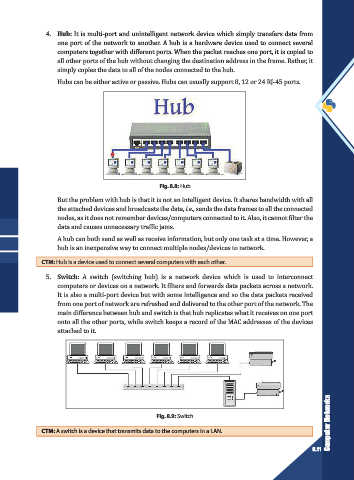Page 165 - PYTHON-12
P. 165
4. Hub: It is multi-port and unintelligent network device which simply transfers data from
one port of the network to another. A hub is a hardware device used to connect several
computers together with different ports. When the packet reaches one port, it is copied to
all other ports of the hub without changing the destination address in the frame. Rather, it
simply copies the data to all of the nodes connected to the hub.
Hubs can be either active or passive. Hubs can usually support 8, 12 or 24 RJ-45 ports.
Fig. 8.8: Hub
But the problem with hub is that it is not an intelligent device. It shares bandwidth with all
the attached devices and broadcasts the data, i.e., sends the data frames to all the connected
nodes, as it does not remember devices/computers connected to it. Also, it cannot filter the
data and causes unnecessary traffic jams.
A hub can both send as well as receive information, but only one task at a time. However, a
hub is an inexpensive way to connect multiple nodes/devices to network.
CTM: Hub is a device used to connect several computers with each other.
5. Switch: A switch (switching hub) is a network device which is used to interconnect
computers or devices on a network. It filters and forwards data packets across a network.
It is also a multi-port device but with some intelligence and so the data packets received
from one port of network are refreshed and delivered to the other port of the network. The
main difference between hub and switch is that hub replicates what it receives on one port
onto all the other ports, while switch keeps a record of the MAC addresses of the devices
attached to it.
Computer Networks
Fig. 8.9: Switch
CTM: A switch is a device that transmits data to the computers in a LAN.
8.11

